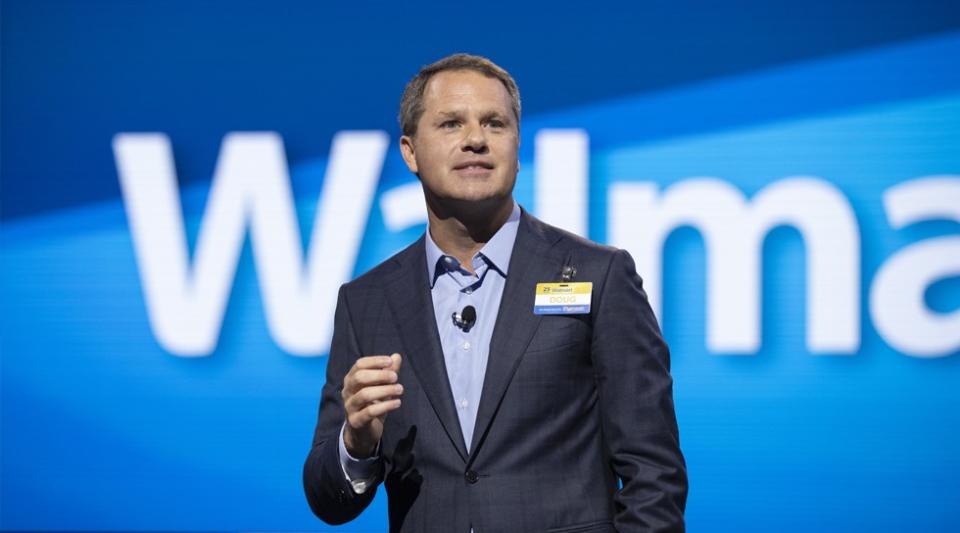Walmart Profit Warning Ripples Across Wall Street and Retail

Walmart Inc.’s profit warning rattled Wall Street and the rest of retail by highlighting some of the key worries of 2022 — from inflation to tough consumer trade offs to a move toward markdowns on fashion.
As dramatic as the outlook adjustment was for the usually solid Walmart — adjusted earnings per share are now slated to be down 11 percent to 13 percent this year instead of down 1 percent — it was more reminder than revelation for retail as a whole.
More from WWD
Target Corp. said last month that it would “right-size” its inventory by ramping up markdowns.
Walmart is following the same thread and effectively reaffirming that, while higher-end consumers are holding on, the budget-minded are having to make some tough choices in an increasingly inflationary economy.
“The increasing levels of food and fuel inflation are affecting how customers spend, and while we’ve made good progress clearing hardline categories, apparel in Walmart U.S. is requiring more markdown dollars,” said Doug McMillon, Walmart’s president and chief executive officer.
Shares of Walmart fell 7.6 percent to $121.97 on Tuesday, helping push the Dow Jones Industrial Average down 0.7 percent, or 228.50 points, to 31,761.54.
Among the other retailers and fashion companies logging declines were Kontoor Brands Inc., down 10.6 percent to $33.20; Kohl’s Corp., 9.1 percent to $26.32; Macy’s Inc., 7.2 percent to $16.79; Levi Strauss & Co., 7.2 percent to $17.73; Hanesbrands Inc., 7.1 percent to $10.34; Ralph Lauren Corp., 6.3 percent to $90.63; PVH Corp., 6 percent to $58.03, and Lululemon Athletica Inc., 5.9 percent to $283.41.
While analysts were watchful — and trying to read the broader retail tea leaves — they were generally standing behind Walmart, which is viewed as a strong player with both scale and expertise navigating tight spots in the economy.
Simeon Gutman, an analyst at Morgan Stanley, described the warning as “another warning shot for retail,” but kept his “overweight” rating on the stock.
Still, Gutman said shares of Walmart might “tread water in the near term.”
“This is a significant revision for a company of Walmart’s scale and historical defensiveness/stability,” he said, noting that while the forces behind the warning were well understood, the magnitude of the earnings revision was surprising. “This narrative is similar to what we’re hearing from other retailers, public and private, including Target, which similarly cut guidance intra-quarter, though much earlier than Walmart.”
The warning also had Gutman’s colleague at Morgan Stanley, technology analyst Brian Nowak, looking hard at Amazon, noting the e-commerce company could see lower merchandise margins in the second half as well.
“The largest retailers continue to face similar [operating expense], inflation, supply chain and consumer spending headwinds,” Nowak said.
Big questions remain for the second half — starting with the back-to-school sales that are ramping up now and lead into the all-important holiday season.
McMillon did note the company was “encouraged by the start we’re seeing on school supplies in Walmart U.S.”

Courtesy Photo
But the competitive pressure remains intense.
Retail foot traffic analytics firm Placer.ai said the back to school season was kicking off with a certain “duality.”
“For retailers, there’s a double-edged sword coming at them in the weeks ahead: Students are going back to in-person classes, in many cases, meaning that they’ll need supplies,” Placer.ai said. “But on the other hand, inflation is eating up consumers’ purchasing power. How brands respond, ultimately, will determine if there are any winners.”
In the long-standing rivalry between Walmart and Target, Placer.ai said the discounters are “on different trajectories.”
“Heading into the back-to-school shopping season, Target’s visits were up 11.1 percent in June compared to 2019, and up 13.5 percent in May,” the analytics firm said. “Walmart, however, saw visits down 3.6 percent in June, and even in May compared to 2019.”
It looks like there might not be any sweeping retail victories for the balance of the year, but a battle for inches as consumers and merchants move forward under the threat of recession.
Sign up for WWD's Newsletter. For the latest news, follow us on Twitter, Facebook, and Instagram.


